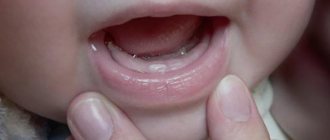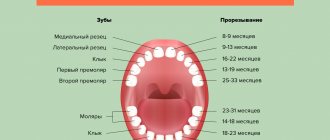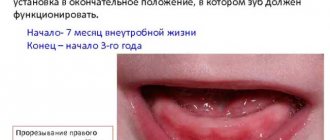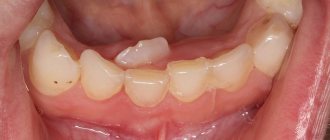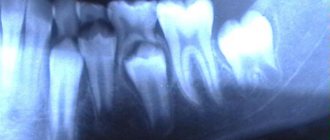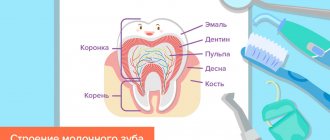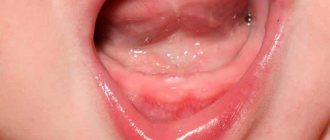Snot (nasal mucus) is a viscous muconasal secretion that has the consistency of mucus and is produced by the secretory glands of the nasal mucosa. The discharge of snot from the nose is called a runny nose or rhinorrhea (one of the symptoms of catarrhal rhinitis). Rhinitis in infants can have different etiologies and be the result of infectious diseases, allergic reactions, atrophic and neurovegetative processes.
Runny nose in infants is a common disease
Snot during teething is most often not associated with pathological changes in the functioning of the airways, and the causes of rhinorrhea during this period are physiological in nature. The use of traditional antiviral, antihistamine and antibacterial drops to treat such a runny nose is unjustified until the true cause of the appearance of snot is determined and the general condition of the child is assessed.
Snot during teething
Rhinorrhea during teething: causes
Baby teeth usually appear in babies at the age of 5-9 months, while the process of teething can begin much earlier - from 3-4 months. The gradual eruption of dental crowns is always accompanied by spontaneous opening of the gums.
Baby teething
This process is quite painful and gives the child a lot of unpleasant sensations and discomfort, so most children during this period become whiny, restless, and capricious. At the same time, almost 60% of infants experience another symptom that is considered characteristic of the eruption of baby teeth in the first year of life - a runny nose.
Teething is often accompanied by a runny nose
There are several reasons that can provoke the appearance of rhinorrhea during teething.
The process and timing of teething depend not only on inherited genetic parameters; the timing of teething can be influenced by external and internal factors. For example, climatic conditions, the course of pregnancy and the nature of nutrition of the mother and child after birth, illnesses of the baby, and more. Read more about the teething schedule for infants on our website.
Reduced immunoresistance
Weakening of immune function during the eruption of dental crowns is a natural reaction of the body to an internal factor that is a mediator of stress. Dentists note that most often, a pronounced immune disorder during this period is observed in children whose teeth appear too early (before 4 months), or, conversely, too late (after 10 months). The risk of a viral or bacterial infection is higher if the following factors are present:
- insufficient hygiene of the baby’s hands and skin;
- poor processing of children's bedding and underwear, toys, feeding utensils, pacifiers;
- irregular wet cleaning in the apartment (especially in the children's room);
- non-compliance with standards for ventilation and humidification of rooms in which the child spends most of his time;
- frequent appearance in crowded places.
Oral hygiene in children
If a child begins to teethe, contact with strangers or people who have recently had a respiratory disease should be temporarily prevented, since the risk of infection during this period is quite high for all children.
While your child is teething, it is worth protecting him as much as possible from possible airborne infections.
Note! Compliance with increased preventive measures during teething is recommended for children suffering from congenital autoimmune diseases (cystic fibrosis, agranulocytosis, diabetes mellitus, etc.).
Strengthening secretory function
A natural protective mechanism during teething is to increase the activity of secretory glands that produce salivary and muconasal secretions. Rhinorrhea is observed mainly in infants with manifestations of hypersalivation (increased salivation), since anatomically the nasopharynx and oropharynx have a similar structure and are located in close proximity to each other.
A runny nose usually bothers babies with increased salivation.
In this case, muconasal mucus is produced by surface epithelial cells located in the mucous membranes of the nose. The secretion contains not only water, mucus and epithelial particles, but also mucin - gel-like high molecular weight mucoproteins that contain a large amount of acidic polysaccharides. If the secretory glands work too actively, the amount of mucus secreted increases several times, which leads to its removal from the nasal cavity through the anatomical openings - the nostrils. In some cases, such snot can flow into the throat along the back wall of the pharynx, causing a cough, which many parents perceive as a symptom of a respiratory infection.
- How to deal with unpleasant odors in the home of a seriously ill person
Coughing may be normal during teething
Stimulation of blood circulation
During teething, the flow of blood and lymph to the vessels located in the oral cavity increases. Increased blood and lymph circulation also occurs in the vessels of the nasal cavity, which has a stimulating effect on the secretory glands and causes increased secretion of muconasal mucus, which is commonly called snot.
Clinical features
“Dental” rhinitis” (“dental runny nose”), which is a type of physiological runny nose, must be distinguished from pathological rhinitis, which can be infectious, allergic and neurovegetative in nature. The physiological secretion of nasal mucus against the background of changes occurring in the child’s body during the period of teething crowns has certain clinical features that need to be paid attention to. Such a runny nose is not accompanied by an increase in temperature, the release of thick yellow, brown or green snot, or the appearance of allergic reactions in the form of a rash or itchy skin.
If the baby has snot and saliva, but there is no fever, it means that another baby tooth will appear soon.
In this case, a dental runny nose may well occur against the background of a slight change in stool due to increased secretion of the salivary glands and the ingestion of a large amount of saliva, which mixes with food and dilutes its consistency. A deterioration in general well-being is also possible, since the process of teeth appearing is quite painful and unpleasant for the child. Physiological rhinitis may also be accompanied by other pathological symptoms, for example, cough, sleep disturbance or refusal to eat, but only a doctor can establish their relationship with the possible presence of infectious pathogens in the body.
Your baby may be fussy and have trouble sleeping during teething.
How to help a child
If at an appointment with a pediatrician it becomes clear that the baby has an acute respiratory viral infection due to teething, the doctor will immediately prescribe treatment. To be sure, you can take a blood test, which will show you what needs to be dealt with. Usually the baby is prescribed:
- vasoconstrictor droplets according to age;
- cough syrup with ambroxol to prevent sputum from stagnating;
- cough tablets - usually Septefril or Lizobact in the permitted dosage;
- saline solution for rinsing the nasal passages;
- antipyretic drugs, for example, Analdim suppositories or suspensions - Panadol, Nurofen.
All medications are prescribed by a doctor - self-medication in this case is unacceptable!
If we are not talking about ARVI, but about a normal reaction to teeth, then when the temperature rises, the baby is given antipyretics, and the nose is washed with saline solution. If the baby is too restless, the gums are smeared with a special anesthetic gel.
Snot on your teeth can be either normal or a sign of infection. It is not difficult to determine their nature - there are many signs that signal that a child has become infected with ARVI. If it is an infection, the mother’s task is to follow the pediatrician’s instructions and do the maximum to ensure that he recovers. To prevent the baby from becoming infected with the virus during the teething period, it is necessary to visit crowded places less (especially during epidemics), wash his toys more often, avoid overheating and hypothermia, and rinse his nose.
Comparative characteristics
To make it easier for parents to navigate the clinical features of rhinitis in infants, the table below provides a comparative description of various types of runny nose with characteristic symptoms and signs.
How to distinguish dental rhinitis from pathological runny nose?
| Criteria (signs and symptoms) | Physiological secretion of nasal mucus | Infectious rhinitis | Allergic rhinorrhea |
| Appearance of snot | The snot has a watery, transparent consistency that persists even after several days. They have no color. | With viral infections, snot is usually watery and has increased viscosity and fluidity. If a bacterial infection is added to a viral infection, the snot becomes thick and acquires a yellowish, green or swampy tint. | The discharge is transparent, has a low degree of viscosity, and some of it causes irritation to the skin under the nose. |
| Number of snot | Moderate to very heavy. | Light to moderate. | From light to very heavy. |
| Smell of mucus | Absent. | With bacterial infections or severe atrophy of the nasal mucosa, the discharge may have a strong, foul odor. | Absent. |
| Factors preceding the appearance of snot | Mucus is released randomly. | The appearance of rhinorrhea is usually preceded by hypothermia, contact with a sick person, or other risk factors for viral and bacterial infections. | A runny nose occurs after contact with various pathogens (dust, animal hair, some foods, etc.). |
| Cough | Available. | Appears almost always. | Possible, often accompanied by itchy nose and sneezing. |
| Body temperature | Normal (moderate hyperthermia is possible within the range of low-grade fever, associated with the fact of painful teething). A physiological increase in temperature to 37.3°-37.5°C lasts no more than 1-2 days. | Increased (may exceed low-grade levels and be accompanied by febrile fever). | Normal. |
An infectious runny nose is also characterized by nasal congestion, impaired nasal breathing, and the appearance of other symptoms of various respiratory diseases.
If your child has a fever, you should call a pediatrician
With allergic rhinorrhea, a child may experience skin itching, rashes and other signs of allergy typical for this group of diseases.
What absolutely should not be done
Let's list what you shouldn't do when a small child has a runny nose:
- give up the idea of using hot steam inhalations: firstly, this is contraindicated if the child has a high fever, and secondly, it can cause a burn to the delicate mucous membranes, respiratory tract and skin. But the use of nebulizers and inhalers with cool steam is allowed, but before use you must consult a doctor,
- do not put honey, propolis and even aloe vera into your nose, as some sources on the Internet advise: this can cause an acute allergic reaction, even greater difficulty breathing and individual intolerance,
- do not do steam baths for your feet: such procedures are contraindicated for children under 3–4 years old,
- You cannot independently treat ARVI in an infant. Consult a doctor!
Other signs of teething
If a baby has clear snot running from his nose for several days in a row, but the child himself feels well and the body temperature remains within normal limits, it is necessary to carefully examine the oral cavity and skin. If pathological rashes and scratching marks are detected on the skin, you should immediately contact an allergist. If everything is fine with the skin, you should conduct a visual examination of the oral cavity. If, along with a runny nose, swelling and redness of the gums are noticeable, most likely the discharge is associated with the process of teething.
- What does snot with blood mean when you have sinusitis? How do you know when you need to see a doctor?
The following symptoms can also be considered signs of the imminent appearance of the first teeth:
- increased secretion of saliva (hypersalivation);
- itching of the gums (the child constantly pulls surrounding objects into his mouth and gnaws on them);
The child massages his gums, sucking and trying to gnaw toys and his fingers with his gums
- stool liquefaction;
- crying and restless behavior during feeding (the child should not twist his legs or pull them towards his stomach);
The baby may not eat well or cry while eating
- the appearance of dense bumps on the surface of the nose.
If the lump turns white, or there are clear signs of gum opening around it, it means that the tooth will erupt within the next 5-7 days.
The lump becomes white, or there are clear signs of gum opening around it
Tips for parents
All parents go through the period of teething in their children. For some children, this process is quite painful, so parents must create all the conditions that will help alleviate the baby’s condition.
If you experience a runny nose, cough or fever, it is very important not to confuse them with a viral infection and not trigger the disease. A qualified pediatrician will definitely distinguish a cold from the symptoms of teething
Parents, in turn, must follow all the doctor’s recommendations:
- Monitor the cleanliness and hygiene of the nasal cavity, clear the nose of dry crusts and mucus.
- Do wet cleaning daily.
- Ventilate the room.
- It is prohibited to use any medicine, especially drops with a vasoconstrictor effect, without consulting a doctor.
- If there is increased saliva production, it should be blotted with a soft towel.
- Spend more time outdoors.
- Buy a special teether.
- Always have an antipyretic and analgesic drug on hand: Nuroven, Panadol.
- Pay more attention to the baby.
By following basic rules, you can significantly improve the baby’s general condition and make the teething process less painful. Many parents note that after the first teeth erupted, the cough and runny nose went away on their own without leaving any consequences. However, in any case, the child should be shown to a pediatrician who can rule out the occurrence of diseases not related to the eruption of baby teeth.
source
Is it necessary to treat “tooth” snot?
One of the most common mistakes that many parents make if their child develops snot is to independently use various medications to combat this problem. The first place in this list is traditionally occupied by various anticongestive drugs that cause constriction of blood vessels and are intended to relieve swelling in the nasal cavity. Such drugs include drops “Nazivin”, “Naphthyzin”, “Xylometazoline” and other drugs with a similar mechanism of action.
The main component of the drug is oxymetazoline hydrochloride
Anticongestants have a large number of side effects, the main of which are the rapid addictive effect and gradual atrophy of the nasal mucosa, which can ultimately lead to the development of chronic atrophic rhinitis. The use of these medications is justified only in severe cases, when the child cannot breathe normally due to severe swelling of the mucous membrane, which happens mainly with infectious rhinitis. Antihistamines that block the production of the main mediator of inflammatory reactions (histamine) are also unacceptable for the treatment of physiological rhinorrhea associated with teething.
Important! Despite the fact that the use of traditional remedies for snot associated with teething is not recommended, it is impossible to completely refuse treatment, since stagnation of mucus in the nose creates an excellent breeding ground for various bacteria and can cause serious complications: otitis media, bronchitis, etc. .d.
The main reasons for the problem
1. Increased blood supply to the mucous membranes of the mouth and nose
Erupting teeth begin to stimulate blood circulation in the mucous membranes of the mouth, causing the baby's gums to itch, redden and swell. However, in our body everything is interconnected, organs such as the nose and mouth are located nearby, plus they have a common blood supply.
Thus, when the first milk units erupt, blood flow is ensured not only to the gums, but also to the nasal mucosa. And this, in turn, contributes to the appearance of swelling and stimulation of cells that secrete mucus.
Increased saliva production
Due to increased blood supply and mechanical irritation of the sensitive nerves of the gums, the salivary glands are activated, and a lot of saliva is released. Due to the proximity of the organs, salivary secretion appears not only in the mouth, but also through the nasopharynx into the nose (for example, when the child is lying down). This often explains why a baby develops a cough and snot when teething.
Saliva in large quantities can not only leak out, but also enter the gastrointestinal tract when swallowed, which provokes stool upset and diarrhea.
3. Weak immunity, development of bacterial and viral infections
When the first teeth come in, it is a great stress for the body, and in most children, against this background, both general and local immunity may decline. In this case, it costs nothing for the baby to catch an infection or become infected from others.
The tooth came out, but the runny nose does not go away
If the tooth has already erupted, but the runny nose still does not go away, and the child feels satisfactory, his body temperature is normal, and the snot retains a watery consistency, perhaps the reason is improper hygienic care and non-compliance with sanitary standards. For the normal functioning of the nasal mucosa, constant hydration is necessary: moistened epithelium effectively binds particles of dust and dirt and removes them from the nasal cavity, preventing them from penetrating further into the airways.
To create physiologically correct conditions for normal functioning of the mucous membranes, it is necessary:
- maintain the required temperature in the children's room (about 20°-22°C for games and 16°-18°C for sleeping);
- ventilate the room at least 6-8 times a day, each ventilation should last about 10-15 minutes;
Don't forget to ventilate the nursery
- regularly carry out wet cleaning, remove dust from furniture, clean toys and carpets (ideally, it is better to remove carpets, thick curtains, books and soft toys from the baby’s room);
- Do not use disinfectants during cleaning (plain water is fine).
Do wet cleaning at least three times a week
Strengthening the immune system is also of great importance, which consists of compliance with the vaccination calendar and the introduction of complementary foods, frequent walks, adequate temperature and movement conditions, and hardening procedures.
Video – Komarovsky about runny nose and teething
Rhinorrhea (snot) during teething is a very common occurrence that should not be confused with an infectious runny nose. Under no circumstances should you give your child antiviral drugs, immunomodulators, antihistamines and anticongestive drugs without consulting your doctor. In most cases, such a runny nose goes away on its own after teething, and to relieve it, it is enough to adhere to a certain hygiene regimen. Read the article for strong painkillers for toothache.
- How long does it take for drugs to leave the body?
Ways to alleviate the condition
What to do and how to treat a runny nose during teething? Here, various methods come to the aid of parents - medications and devices, a certain diet and conditions in the room where the baby is constantly present. Let's take a closer look at them.
“With my older child, we had no problems with teeth. And the youngest one showed it in full – he’s snot streaming, which means he’s teething. In principle, the drops helped, but not for long. So the whole family had to listen to the whims for 2-3 days, and, of course, they didn’t get enough sleep. And then everything passed quickly.”
Polina K., review from baby.ru
What is causing this problem?
There are several suggestions why a runny nose becomes a concomitant symptom of teething in infants.
The first reason is the state of immunity. When children are fed only mother's milk, they receive a sufficient amount of antibodies. At the time when the first teeth begin to appear, the child is gradually fed with other foods, and sometimes completely transferred to artificial nutrition. The baby is deprived of the constant protection that is provided to him through breast milk, so the body’s defenses become weaker. In addition, during teething, young children experience such severe pain that not even every adult can withstand. It takes a lot of strength to overcome them, which is what the body spends it on.
How does a physiological cough manifest in children?
During the growth of teeth, children's gums hurt very much. They swell, turn red, and itch. Pain during tooth growth can radiate into the jaw or into the orbit, depending on the location of the tooth. Pain syndrome disrupts the baby's sleep pattern and increases anxiety. The baby constantly cries and is nervous, pulling his fingers into his mouth. During this period, the baby's mood changes. The pain prevents the child from eating normally, so he often refuses to eat.
When a tooth breaks through the gum, the child's salivation increases. Throughout the day and night, saliva is released abundantly. More often it flows out through the lips, causing redness around the mouth. The formation is very itchy and painful.
Saliva may flow into the back of the throat, causing choking and coughing. The sputum with this cough reflex is liquid and transparent. It appears due to the accumulation of saliva in the tracheal cavity.
Often parents do not know how long a physiological cough lasts. The duration of the symptom is usually 2-3 days. If the duration of the cough reflex increases, you should consult a doctor.
During teething, the baby cries a lot. Prolonged and frequent crying leads to dryness of the mucous membrane of the trachea and larynx. Infants drink little because their appetite is poor. Due to the dryness of the mucous membrane of the upper respiratory tract, a cough reflex occurs. He has no phlegm. A dry cough additionally irritates the walls of the trachea and larynx, which can contribute to its intensification.
At night, the baby may have coughing attacks. The cough reflex caused by dry mucous membranes is more stable. If saliva flows into the tracheal cavity, then after coughing up the sputum, the cough reflex stops and the baby falls asleep.
In medicine there is such a concept: severe teething syndrome. He talks about the presence of a cough, runny nose, and severe choking during teeth growth. With such a severe course, even a slight increase in temperature is possible.
In what cases should you consult a doctor?
Until the child leaves infancy, the pediatrician should be informed about all changes in his health and behavior.
You should visit a doctor as soon as possible if:
- cough occurs in attacks;
- accompanied by audible wheezing;
- purulent sputum is rejected;
- the child refuses to eat and drink;
- temperature rises beyond 38℃;
- antipyretics do not help;
- Vomiting or severe diarrhea occurs.
You need to visit the pediatrician again if the cough and other signs of teething do not disappear for more than 6-7 days. A child may get sick after symptoms appear, and parents will think that it is because of the teeth.
How to distinguish normality from pathology
| Symptom | Norm | Pathology |
| Cough |
|
|
| Runny nose | Often occurs against the background of the eruption of fangs and incisors (“eye teeth”): the secretion secreted from the nose is always transparent and liquid, reminiscent of water | The secretion from the nose was only liquid and transparent at first, but after 1-3 days it thickened, the snot became yellowish or green. Nasal congestion appeared. |
| Temperature | 1-2 days before teething, the temperature can rise to 37.5-38 degrees. Easily removed with antipyretics. | High fever is difficult to control with medications such as Nurofen and Ibuprofen and increases quickly. |
| Vomiting and diarrhea | No vomiting. Diarrhea can be observed for several days, but no more than 2-3 times a day. | May be. If vomiting is accompanied by diarrhea, it indicates the appearance or addition of rotavirus or intestinal infection. |
When teething, a large amount of saliva is released, which flows from the mouth onto the baby’s chin and lips, and the skin around the lips becomes irritated and reddened from constant humidity, and a rash may even appear on it. You also have to change the baby’s clothes almost every hour, because the baby’s entire chest is also covered in drool. All these are signs that the cough is not a symptom of pathology or a serious illness. In this case, there is no reason to panic, just do not forget to wash the child’s face with water more often and remove drool with a handkerchief. Use ointments and powders to relieve skin irritation.
According to some famous doctors and pediatricians, coughing on teething teeth can occur either wet or dry. Most often, it appears after the baby has been crying for a long time, as a result of which breathing becomes difficult and the throat becomes dry and sore, which is why the so-called “cough reflex” develops. In particular, Dr. Komarovsky shares this opinion.
